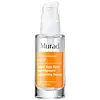What's inside
What's inside
 Key Ingredients
Key Ingredients

 Benefits
Benefits

 Concerns
Concerns

 Ingredients Side-by-side
Ingredients Side-by-side

Hippophae Rhamnoides Water
MaskingPropanediol
SolventAscorbic Acid
Antioxidant1,2-Hexanediol
Skin Conditioning3-O-Ethyl Ascorbic Acid
Skin ConditioningTromethamine
BufferingFerulic Acid
AntimicrobialDiglycerin
HumectantEthylhexylglycerin
Skin ConditioningPolyglycerin-3
HumectantGlycerin
HumectantNiacinamide
SmoothingWater
Skin ConditioningCalcium Pantothenate
Sodium Starch Octenylsuccinate
AbsorbentMaltodextrin
AbsorbentSodium Ascorbyl Phosphate
AntioxidantTocopheryl Acetate
AntioxidantPyridoxine Hcl
Skin ConditioningSilica
AbrasiveHippophae Rhamnoides Water, Propanediol, Ascorbic Acid, 1,2-Hexanediol, 3-O-Ethyl Ascorbic Acid, Tromethamine, Ferulic Acid, Diglycerin, Ethylhexylglycerin, Polyglycerin-3, Glycerin, Niacinamide, Water, Calcium Pantothenate, Sodium Starch Octenylsuccinate, Maltodextrin, Sodium Ascorbyl Phosphate, Tocopheryl Acetate, Pyridoxine Hcl, Silica
Water
Skin ConditioningAlcohol Denat.
AntimicrobialGlycolic Acid
BufferingButylene Glycol
HumectantGlycerin
HumectantMethyl Gluceth-10
EmulsifyingDextran
Hexapeptide-2
BleachingRice Amino Acids
Skin ConditioningAloe Barbadensis Leaf Juice
Skin ConditioningUrea
BufferingYeast Amino Acids
HumectantTrehalose
HumectantInositol
HumectantTaurine
BufferingBetaine
HumectantZinc Gluconate
Skin ConditioningAscorbic Acid
AntioxidantChitosan
Propyl Gallate
AntioxidantNonyl Nonoxynol-10
Lecithin
EmollientTocopherol
AntioxidantMagnesium Ascorbyl Phosphate
AntioxidantDipotassium Glycyrrhizate
HumectantPalmitoyl Hydroxypropyltrimonium Amylopectin/Glycerin Crosspolymer
Skin ConditioningVitis Vinifera Seed Extract
AntimicrobialChitosan PCA
HumectantAllantoin
Skin ConditioningPolyquaternium-10
Sodium Metabisulfite
AntioxidantSodium Sulfite
PreservativeSodium Hydroxide
BufferingPPG-26-Buteth-26
Skin ConditioningPEG-40 Hydrogenated Castor Oil
EmulsifyingHydroxyethylcellulose
Emulsion StabilisingDisodium EDTA
Limonene
PerfumingLinalool
PerfumingParfum
MaskingWater, Alcohol Denat., Glycolic Acid, Butylene Glycol, Glycerin, Methyl Gluceth-10, Dextran, Hexapeptide-2, Rice Amino Acids, Aloe Barbadensis Leaf Juice, Urea, Yeast Amino Acids, Trehalose, Inositol, Taurine, Betaine, Zinc Gluconate, Ascorbic Acid, Chitosan, Propyl Gallate, Nonyl Nonoxynol-10, Lecithin, Tocopherol, Magnesium Ascorbyl Phosphate, Dipotassium Glycyrrhizate, Palmitoyl Hydroxypropyltrimonium Amylopectin/Glycerin Crosspolymer, Vitis Vinifera Seed Extract, Chitosan PCA, Allantoin, Polyquaternium-10, Sodium Metabisulfite, Sodium Sulfite, Sodium Hydroxide, PPG-26-Buteth-26, PEG-40 Hydrogenated Castor Oil, Hydroxyethylcellulose, Disodium EDTA, Limonene, Linalool, Parfum
Ingredients Explained
These ingredients are found in both products.
Ingredients higher up in an ingredient list are typically present in a larger amount.
Ascorbic Acid is is pure Vitamin C. This form makes up the largest amount of vitamin C found naturally in our skin.
Not only is vitamin C great for your overall health and immune system, it also has plenty of benefits on your skin.
Vitamin C is best used for brightening skin. It improves dark spots, acne scars, and hyperpigmentation. This is because it blocks the process of skin darkening when exposed to UV.
Remember: Vitamin C should not replace sunscreen!
Your skin uses vitamin C to build collagen. Collagen is one key component in having a strong skin barrier and plump skin. Vitamin C also plays a role in regulating collagen, thus making it effective in improving wrinkles and fine lines.
Ascorbic acid shows potent antioxidant activity. As an antioxidant, it helps fight free-radicals. Free-radicals are molecules that may damage your skin cells. These antioxidants also protect skin against UV damage.
The best formulations include Vitamin E and/or ferulic acid. These two ingredients help stabilize and provide a boost in the benefits of ascorbic acid. This is because ascorbic acid becomes unstable when exposed to UV and air. In fact, you can tell your ascorbic acid has oxidized when it turns an orange-yellow color.
Ascorbic acid is generally compatible with other ingredients. However, using ascorbic acid with other active ingredients might cause irritation. Two ingredients: copper ions and benzoyl peroxide, will inactivate ascorbic acid completely.
Read more about other types of Vitamin C:
Foods rich with vitamin C include oranges, strawberries, broccoli, bell peppers, and more. When consuming Vitamin C, your skin receives a portion of the nutrients.
Learn more about Ascorbic AcidGlycerin is already naturally found in your skin. It helps moisturize and protect your skin.
A study from 2016 found glycerin to be more effective as a humectant than AHAs and hyaluronic acid.
As a humectant, it helps the skin stay hydrated by pulling moisture to your skin. The low molecular weight of glycerin allows it to pull moisture into the deeper layers of your skin.
Hydrated skin improves your skin barrier; Your skin barrier helps protect against irritants and bacteria.
Glycerin has also been found to have antimicrobial and antiviral properties. Due to these properties, glycerin is often used in wound and burn treatments.
In cosmetics, glycerin is usually derived from plants such as soybean or palm. However, it can also be sourced from animals, such as tallow or animal fat.
This ingredient is organic, colorless, odorless, and non-toxic.
Glycerin is the name for this ingredient in American English. British English uses Glycerol/Glycerine.
Learn more about GlycerinWater. It's the most common cosmetic ingredient of all. You'll usually see it at the top of ingredient lists, meaning that it makes up the largest part of the product.
So why is it so popular? Water most often acts as a solvent - this means that it helps dissolve other ingredients into the formulation.
You'll also recognize water as that liquid we all need to stay alive. If you see this, drink a glass of water. Stay hydrated!
Learn more about Water